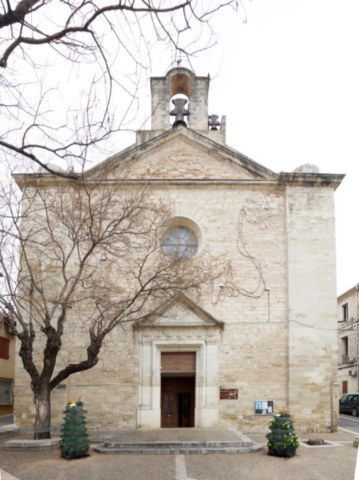Vauvert
The Church of Our Lady of the Assumption in Vauvert: Between Legend, Faith, and History
In the center of the town of Vauvert, at the gateway to the Gard Camargue region, stands a massive and majestic church, discovered around a lively square: Our Lady of the Assumption. This church, heir to a long local spiritual tradition, blends neo-Gothic architecture, medieval legends, and memories of one of the most mysterious figures in the religious history of Languedoc: the famous Abbey of Psalmodie and the legend of the "Vauvert," the mythical beast said to haunt the place.
Medieval Origins: The Shadow of Psalmodie and the Legend of the Desert
Before the current church, the site of Vauvert was dominated, from the top of its hill, by a very ancient spiritual presence: the Abbey of Psalmodie, probably founded in the 6th century by Benedictine monks. Located a few kilometers away, near Aigues-Mortes, the abbey extended its influence for centuries throughout the southern part of the Diocese of Nîmes, and Vauvert became a place of pilgrimage and passage.
In the Middle Ages, a hermitage, then a chapel dedicated to Our Lady of the Green Valley, is mentioned in the archives. The name of the town, Vauvert ("Green Valley"), is said to come from this term, but it is also associated with a popular legend: that of a place haunted by demons and terrifying noises, known as "Grand Vauvert," which Saint Louis supposedly had spiritually cleansed in order to establish a religious house there.
This legendary past, tinged with mysticism, deeply marked the local collective memory.
The current church: a 19th-century reconstruction
The Church of Our Lady of the Assumption that we see today does not date from the Middle Ages, but from the second half of the 19th century. It was built between 1858 and 1867, at a time when the town of Vauvert was experiencing a demographic and economic boom, linked in particular to the rise of viticulture, the development of transportation, and modern urban planning.
The ecclesiastical and municipal authorities then decided to provide the town with a new, larger, and more modern church to replace the old building, which had become dilapidated and too small. The project, entrusted to a diocesan architect, was part of the great Catholic revival movement under the Second Empire, marked by the construction of Neo-Gothic churches throughout France.
Architecture: A Neo-Gothic Interpretation of the Sacred
The church of Vauvert is a fine example of Late Gothic architecture reinterpreted in the 19th century. The building features a tripartite façade dominated by a tall bell tower-porch, flanked by buttresses and surmounted by an octagonal spire. The central rose window, pointed arches, and ornamental pinnacles are reminiscent of the great Gothic cathedrals of northern France, adapted here to the dimensions of a medium-sized southern city.
Inside, the single, vast, and luminous nave is lined with side chapels dedicated to various saints, including the Virgin Mary, Saint Joseph, Saint Theresa, and Saint Joan of Arc. The raised choir is decorated with stucco and murals, some dating from the first decades of the 20th century.
The entire building is constructed of blond limestone from regional quarries, and the vaults are adorned with projecting ribs. The stained-glass windows, created by local or Lyonnais master glassmakers, depict scenes from the lives of Mary, Christ, and popular saints of Languedoc.
A place of worship rooted in local life
Since its construction, the Church of Our Lady of the Assumption has been the spiritual heart of Vauvert. It hosts major religious ceremonies, as well as major traditional festivals, including the town's votive festival in August, where bulls, horses, and pilgrimages mingle in a typically Camargue atmosphere.
The Feast of the Assumption, on August 15, is celebrated with solemn services and processions through the town's streets, perpetuating a long-standing bond between the population and their patron saint. The church square, vast and shaded, is also a place for social and cultural gatherings.
Heritage and Memory
The church has undergone successive restorations, particularly in the late 20th and early 21st centuries, to consolidate the roof, restore damaged stained-glass windows, and preserve the interior decorations. It is not listed as a historic monument in its entirety, but some of its elements, such as the organ and certain liturgical works, are protected as movable heritage sites.
More discreet than the great Gothic sanctuaries, the church of Vauvert nevertheless offers a precious testimony to the popular religiosity of the 19th century, in a region marked by rural Catholicism, historic Protestantism, and influences from the Camargue region of Gard.
Between faith, legend, and the Camargue
The Church of Our Lady of the Assumption is today a vibrant place, a witness to the
Between Faith, Legend, and the Camargue
The Church of Our Lady of the Assumption is today a vibrant place, a testament to the region's cultural and religious diversity. It is open to visitors, worshippers, and those curious to better understand the history of Vauvert. It embodies, in its own way, the spirit of the town: proud of its past, rooted in its traditions, and looking toward the future.
